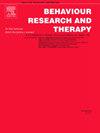对不确定性的不容忍会增强青少年在感知型任务和类别型任务中的恐惧泛化:fNIRS 研究。
IF 4.2
2区 心理学
Q1 PSYCHOLOGY, CLINICAL
引用次数: 0
摘要
恐惧泛化在青春期会发生明显的变化,这可能与焦虑症的高发病率有关。虽然不确定性不耐受(IU)是放大恐惧泛化的一个关键因素,但它在青春期的影响和神经基础仍不清楚。在此,我们研究了 IU 对 12-15 岁青少年基于知觉(72 人)和基于类别(68 人)的恐惧泛化的影响。具体来说,实验一以两个不同大小的圆环作为条件刺激,以中等大小的圆环作为泛化刺激;实验二以麻雀和冰箱的图片作为条件刺激,以与麻雀相关的其他动物作为泛化刺激。我们在两个实验中都收集了自我报告的威胁预期、反应时间和恐惧评级,并在实验 2 中进行了功能性近红外光谱分析。结果表明,与低 IU 青少年相比,高 IU 青少年在两个实验中都有更高的威胁预期。此外,在基于类别的泛化中,高 IU 青少年的恐惧评级更高,反应时间更短,左侧背外侧前额叶皮层(DLPFC)的参与度更低。研究结果表明,IU可能会因左侧DLPFC的招募不足而增强恐惧泛化。这些发现共同表明,行为和神经机制可能会使青少年容易患上精神疾病。本文章由计算机程序翻译,如有差异,请以英文原文为准。
Intolerance of uncertainty enhances adolescent fear generalization in both perceptual-based and category-based tasks: fNIRS studies
Fear generalization undergoes marked changes during adolescence, which may relate to the high prevalence of anxiety disorders. While intolerance of uncertainty (IU) is a key factor that amplifies fear generalization, its impact and neural basis in adolescence remain unclear. Here, we investigated the effects of IU on perceptual-based (n = 72) and category-based (n = 68) fear generalization in adolescents aged 12–15 years. Specifically, Experiment 1 utilized two different size rings as conditioned stimuli, with middle-sized rings serving as the generalized stimuli; Experiment 2 employed pictures of sparrows and refrigerators as conditioned stimuli, with other animals categorically related to the sparrow as generalized stimuli. We collected self-reported threat expectancy, response times, and fear ratings in both experiments, and conducted functional near-infrared spectroscopy in Experiment 2. Results showed that high IU adolescents had higher threat expectancy in both experiments compare to low IU. Moreover, in category-based generalization, high IU adolescents had higher fear ratings, shorter response times and reduced engagement of the left dorsolateral prefrontal cortex (DLPFC). Results indicated that IU may enhance fear generalization by deficient left DLPFC recruitment. Together the present findings point to a behavioral and neural mechanism that can render adolescents vulnerable for mental disorders.
求助全文
通过发布文献求助,成功后即可免费获取论文全文。
去求助
来源期刊

Behaviour Research and Therapy
PSYCHOLOGY, CLINICAL-
CiteScore
7.50
自引率
7.30%
发文量
148
期刊介绍:
The major focus of Behaviour Research and Therapy is an experimental psychopathology approach to understanding emotional and behavioral disorders and their prevention and treatment, using cognitive, behavioral, and psychophysiological (including neural) methods and models. This includes laboratory-based experimental studies with healthy, at risk and subclinical individuals that inform clinical application as well as studies with clinically severe samples. The following types of submissions are encouraged: theoretical reviews of mechanisms that contribute to psychopathology and that offer new treatment targets; tests of novel, mechanistically focused psychological interventions, especially ones that include theory-driven or experimentally-derived predictors, moderators and mediators; and innovations in dissemination and implementation of evidence-based practices into clinical practice in psychology and associated fields, especially those that target underlying mechanisms or focus on novel approaches to treatment delivery. In addition to traditional psychological disorders, the scope of the journal includes behavioural medicine (e.g., chronic pain). The journal will not consider manuscripts dealing primarily with measurement, psychometric analyses, and personality assessment.
 求助内容:
求助内容: 应助结果提醒方式:
应助结果提醒方式:


